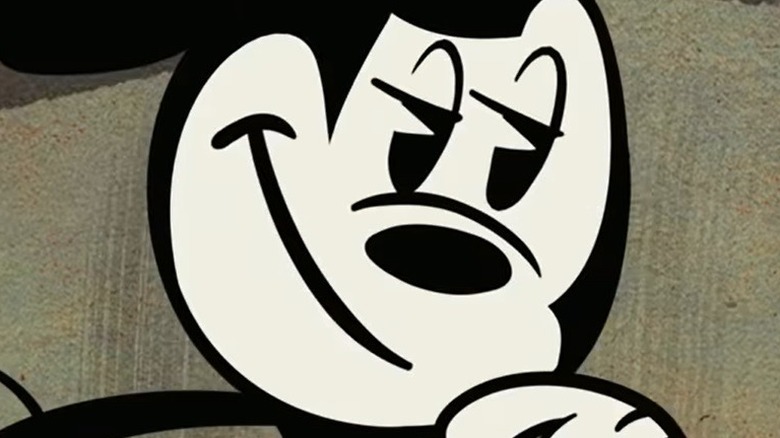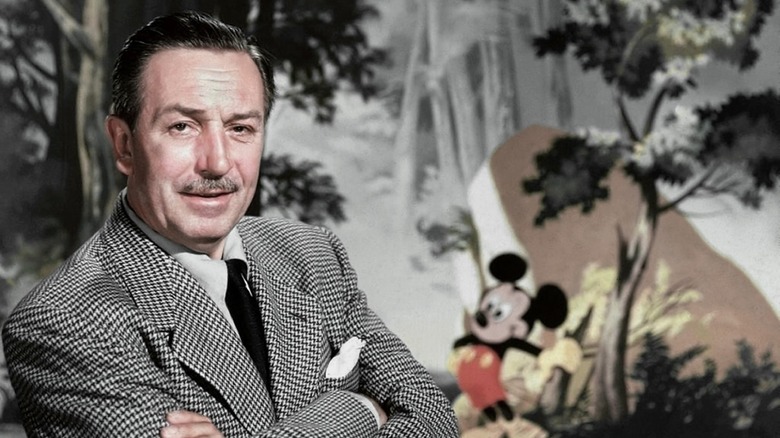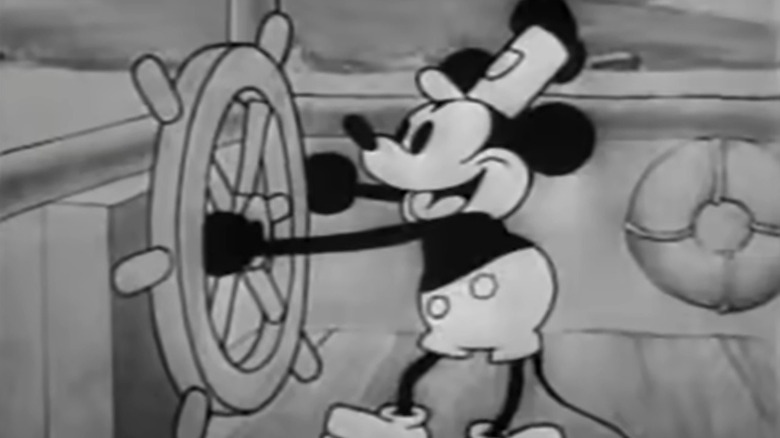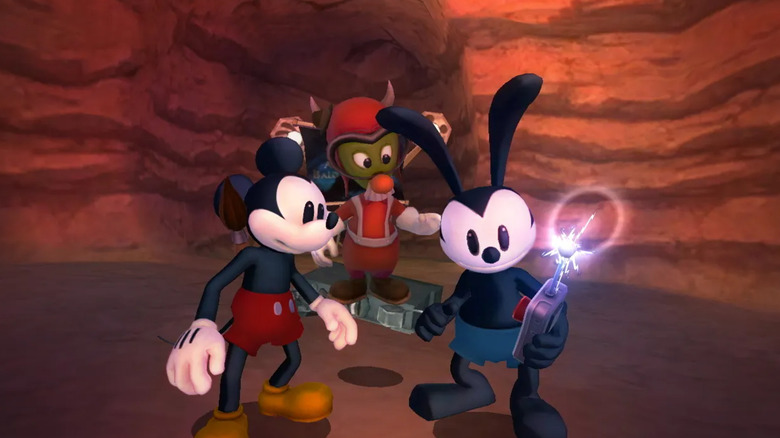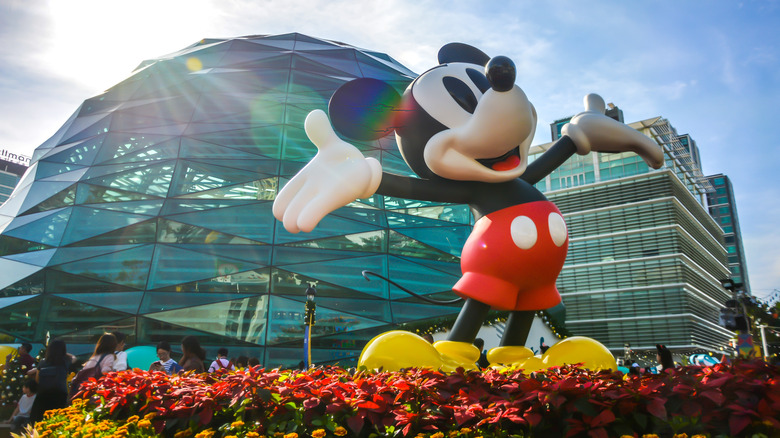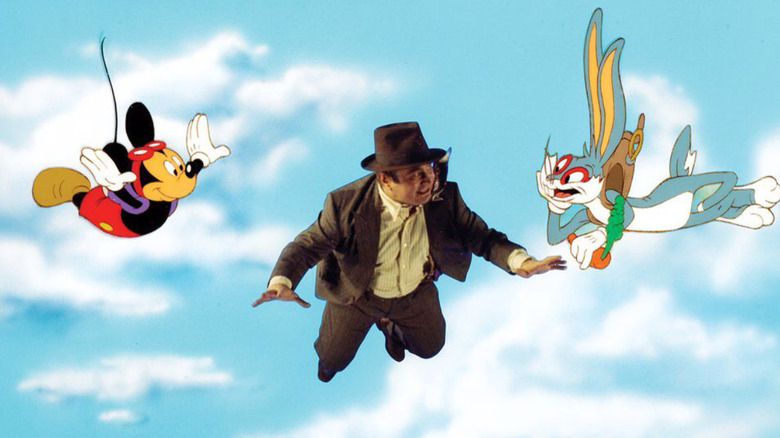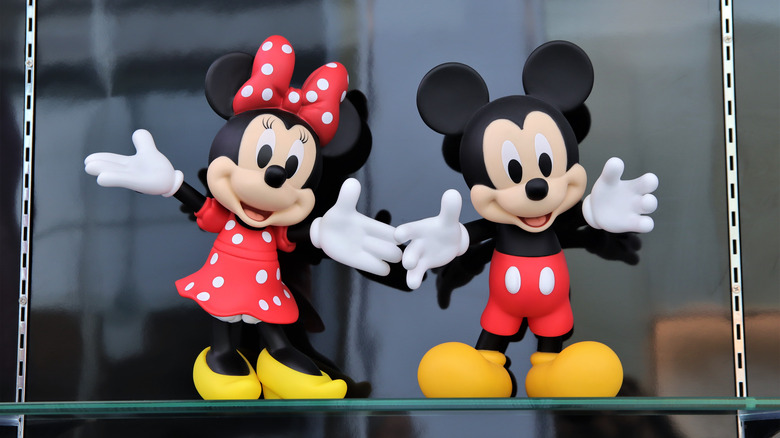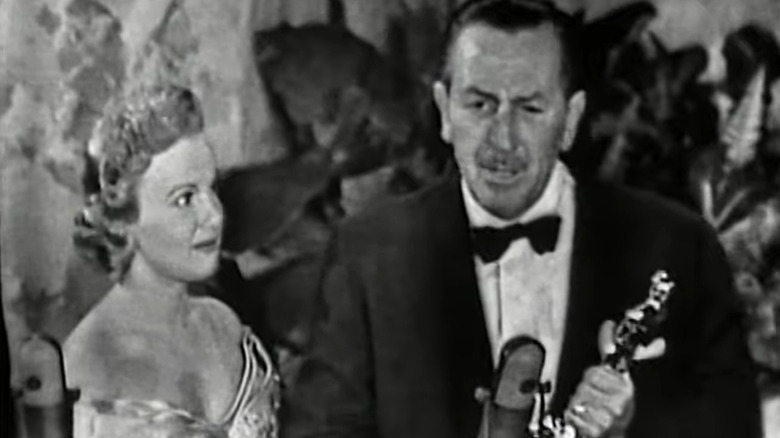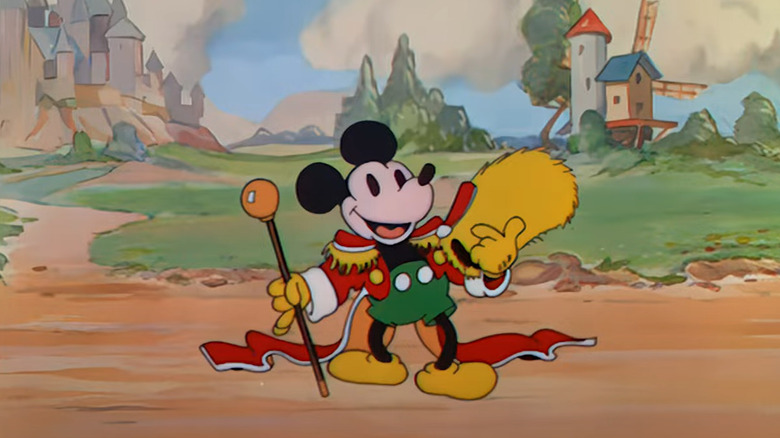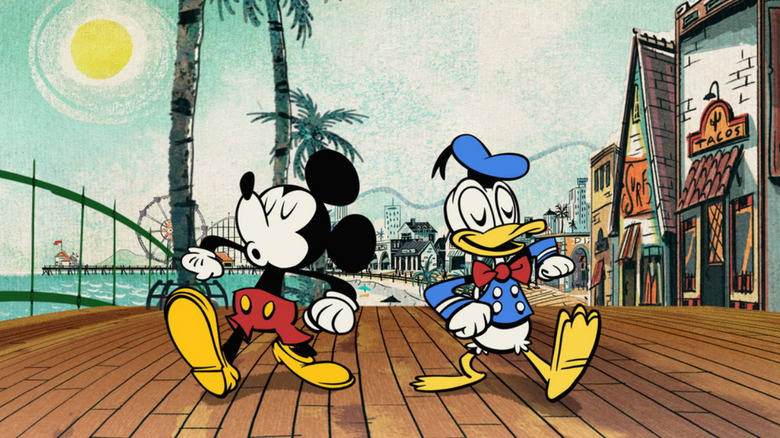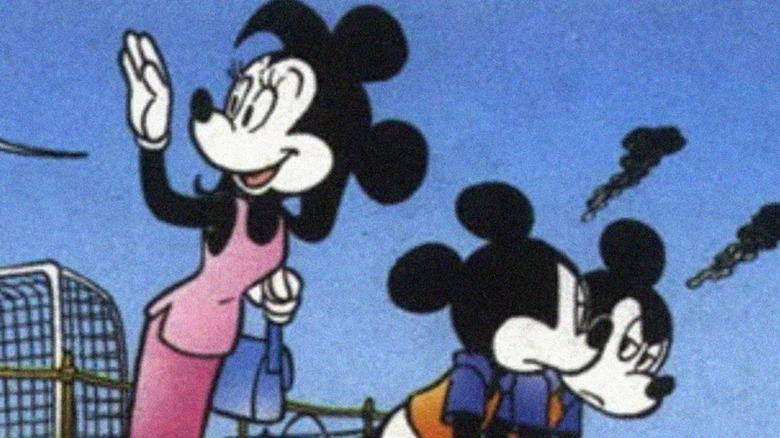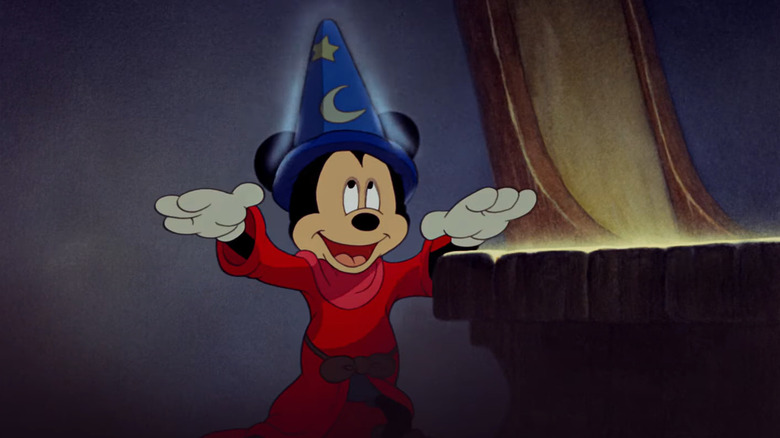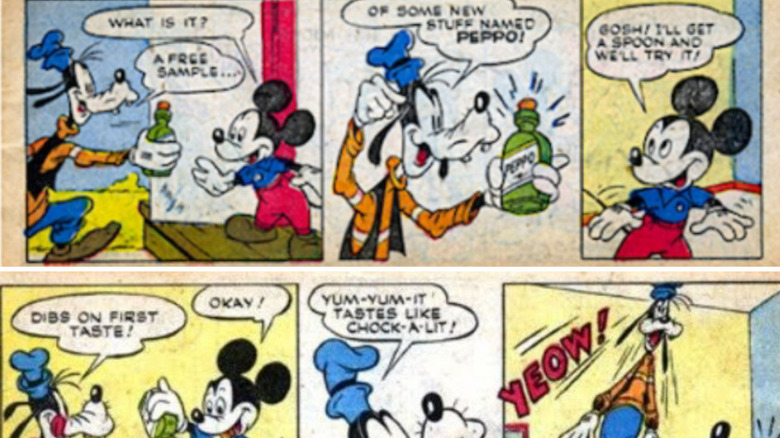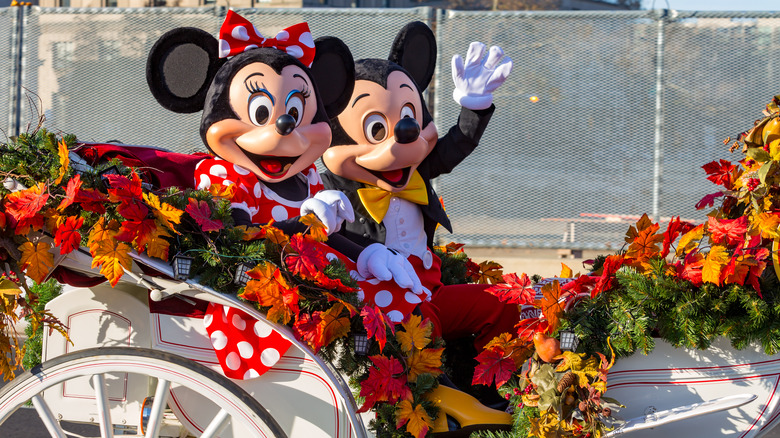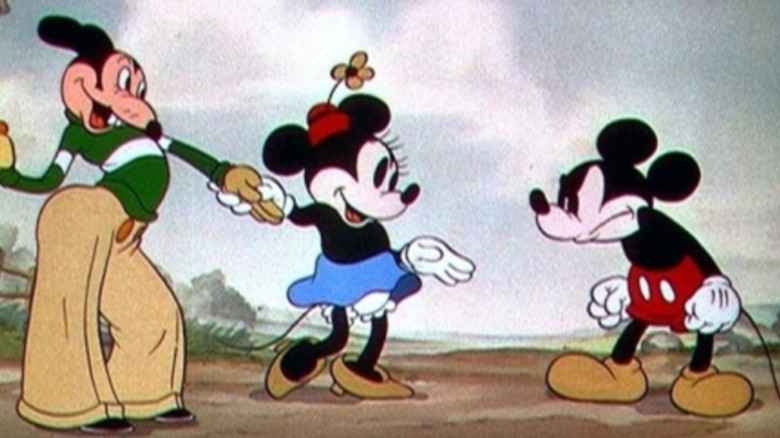The Untold Truth Of Mickey Mouse
Today, Disney is known for a lot of things. The studio has beautiful fairy tale princesses who battle witches and curses to ultimately find their Prince Charming, MCU superheroes with badass powers who take on universe-ending threats, and a whole slate of iconic comedy shows that revolve around tweens and high schoolers.
But above all these popular creations that have made Disney one of the most powerful entertainment studios on the planet, there looms the towering shape of Mickey Mouse. One of Disney's earliest creations — and a character that's defined the company for generations — Mickey is the happy-go-lucky company mascot who's been at the forefront of Disney's inexorable march towards dominating the entertainment landscape.
Despite his iconic status, Mickey's popularity today is not what it once was. These days, the iconic mouse is known more for being the face of Disney rather than a character in his own right, but he possesses a rich history and a complex backstory that stretches over several decades. And if you want to learn more about the beloved cartoon character, read on for the untold truth of Mickey Mouse.
The secret hand behind Mickey's creation
Pop culture loves the idea of a central genius who's single-handedly responsible for the success of an entire company. But the truth is, Steve Jobs needed Steve Wozniak to make the first Apple computer, and Stan Lee needed Jack Kirby to come up with so many iconic Marvel Comics characters.
So what about the creation of Mickey Mouse? It's a well-known fact that Walt Disney came up with the design for Mickey Mouse during a train ride back from a business meeting that had not gone well. During one of his lowest moments — his studio, Laugh-O-Gram, had gone bankrupt, and his character, Oswald the Rabbit, had been taken from him – Disney conceived of the idea of a mouse character that would eventually become Mickey. "He popped out of my mind onto a drawing pad 20 years ago on a train ride from Manhattan to Hollywood," Disney recalled in a 1948 essay.
He took his rough initial sketch to his friend and business partner Ub Iwerks, the legendary animator who was responsible for many future innovations that the Disney company brought about in the industry. Iwerks reworked and refined the sketch of the mouse that had been handed to him into the iconic design that's today known throughout the world. Finally, it was Walt Disney's wife, Lillian, who suggested that the mouse's name should be changed from "Mortimer" to "Mickey," and thus the legend was born.
One of the first cartoons to have sound
Animation has come a long way, to the point where it can be difficult to tell the difference between real life and cartoons. Much of the groundwork in the field of animation was laid down by Walt Disney and his studio. And Mickey Mouse was at the forefront of that work as Disney's flagship character.
After conceiving of the character, Disney created two shorts centering around Mickey in 1928 called "Plane Crazy" and "The Gallopin' Gaucho." Unfortunately, neither short managed to generate interest among distributors, and they were quietly shelved. Then Disney created a new black-and-white short for Mickey, the iconic "Steamboat Willie," which saw Mickey as the captain of a steam river sidewheeler. Disney performed all the voices in the short, including Mickey's.
The cartoon was an immediate hit with audiences. To make it stand apart from the competition, Disney added synchronized sound to "Steamboat Willie," as well as a fully post-produced soundtrack. This was a very rare practice for cartoons at the time. "The effect on our little audience was nothing less than electric," Disney later recalled of the short's initial test screening. "They responded almost instinctively to this union of sound and motion." "Steamboat Willie" went on to become a landmark project for both Disney and the world of animation.
Mickey was a replacement for Oswald the Rabbit
Today, Mickey Mouse's association with Disney might almost seem like fate or destiny. But the truth is the creative process is largely hit-and-miss, and Mickey wasn't the first character Disney conceived of as the rock upon which to build his empire. That credit goes to "Oswald the Lucky Rabbit."
In 1927, Disney created Oswald for Universal Pictures. The character was featured in many animated short films that were released to theaters from 1927 to 1938. Through Oswald, Disney explored the then-untouched genre of "personality animation," where cartoons had specific character traits and believable emotional arcs. As Disney explained (via The New York Times), "I want the characters to be somebody. I don't want them just to be a drawing."
The "Oswald" cartoons were hugely popular, but Disney saw little in the way of profits come his direction, as Universal owned the rabbit's copyright. As a result, he walked away from Universal and came up with Mickey Mouse as a replacement for Oswald — a character that Disney would have full creative and financial control over. In 2006, Walt Disney Studios acquired the rights to Oswald from his parent company. The character appeared in Disney's 2010 video game, "Epic Mickey," where he's shown to be feeling abandoned by Disney and envious of Mickey Mouse.
The Mickey Mouse Protection Act
Disney is a notoriously litigious company that zealously guards its copyrighted content. This sort of behavior is not a new thing. Since Mickey Mouse is the face of the company, Disney has gone to great lengths to hold on to the full copyright over the character dating back to his earliest appearances.
The Copyright Term Extension Act is used to prolong copyright in the United States for decades past the point where the copyright ownership over a creative work is supposed to expire and the work becomes free to use. And since 1990, the Walt Disney Company had been furiously engaged in filing for copyright extension. Thanks to those efforts, lawmakers decided to delay entry of the earliest Mickey Mouse movies into the public domain.
Due to the prominence of the case, the Extension Act was nicknamed "The Mickey Mouse Protection Act." So even in the world of copyright law, you can't get away from the long arm and gloved hand of Mickey Mouse.
The only time Mickey met his rival, Bugs
Within the world of Disney, Mickey Mouse holds a hallowed place as the face of the company. But Mickey isn't the only iconic cartoon character in the world. Many other studios have created their own immensely popular animated characters who've come to rival Mickey's dominance, like Bugs Bunny, the wily rabbit who did what Oswald the Rabbit could not — challenge Mickey's popularity.
Of course, Bugs is owned by Warner Bros., and as a result, there was little chance of him ever meeting Disney's Mickey Mouse except in the imagination of fans. But Disney's 1988 classic "Who Framed Roger Rabbit" managed to make the impossible happen.
Steven Spielberg was on board as a producer for the project, and he was able to use his connections to convince Warner Bros. to lend Bugs to them for a small cameo in the film. Warner agreed on the stipulation that Bugs would only appear opposite Mickey and both would have equal screen time. "Who Framed Roger Rabbit" remains the only time the two cartoon icons have shared screen space together.
The reason behind Mickey's distinct look
Despite being technically presented as a "mouse," the truth is there's nothing much "mouse-like" about Mickey, especially when compared to, say Jerry from "Tom and Jerry." While a cute rodent was the original inspiration behind Mickey's creation, Walt Disney and his company's main preoccupation was with making a recognizable character.
To that end, many parts of Mickey's design were tweaked to make him more accessible. Unfortunately, making a character accessible to a 1920s audience wasn't always a good thing. For instance, his early appearance and mannerisms have been noted to closely resemble the stylings of "blackface minstrel" entertainment, which was widespread in the U.S. at the time and which the audience could easily recognize.
Mickey's gloved hands were also given a redesign to make them more human after their first appearance in the 1928 short "Plane Crazy," when they were black like the rest of Mickey's body with five fingers. Walt Disney himself explained (via The Guardian), "We didn't want [Mickey] to have mouse hands because he was supposed to be more human." And so Mickey was given white gloves to wear, which would contrast against his body and be easily visible at all times. (They were also borrowed from blackface stereotypes.)
As for those five digits, Disney went on to explain that the number of Mickey's fingers were brought down to four because five fingers were deemed too many for Mickey's small frame, and reducing the number of fingers also made the animation process easier.
Mickey Mouse earned Disney an honorary Oscar
Mickey Mouse brought about a lot of firsts for the animation industry. Or it would be more accurate to say that Mickey happened to be at the forefront of a lot of the technical innovations that were sweeping the animation industry at the time, which made the rest of Hollywood sit up, take notice, and give cartoons the respect they deserved.
Back in 1933, Mickey's popularity had been steadily increasing, going global with the success of "Steamboat Willie" four years ago. In order to acknowledge the sea change that Walt Disney had wrought in the animation industry with the creation of Mickey Mouse, the animator was awarded an honorary Academy Award. At that same ceremony, Disney would pick up another statue for the short "Flowers and Trees," and according to D23, the man would go on to win 30 more. But it's pretty amazing to know that Mickey himself helped Disney snag one of his very first trophies.
Mickey's first in-color appearance was quite different
Mickey Mouse started out as a black-and-white cartoon. A few years of explosive popularity later, Mickey was ready for his full-color close-up. Of course, the mouse's white gloves and red pants have become inextricably linked to his identity, which is why it's surprising to consider the first in-color appearance of Mickey had quite a different look.
In 1932, Disney created a short for the 5th Academy Awards ceremony called "Parade of the Award Nominees." In the short Mickey, along with a few other Disney characters, can be seen leading a parade of caricatured nominees for Best Actor and Best Actress. It's the first time Mickey appears in color, and he can be seen wearing green pants and yellow gloves.
That short was something that Disney had done solely for the Academy Awards. A few years later in 1935, it was time for Mickey's official first color film, "The Band Concert." The studio had to decide whether to stick to the green-and-yellow scheme or follow the red-and-white look that had already been extensively used in Mickey Mouse merchandise. Ultimately, Disney decided to go with the better known "red shorts and white gloves" look.
Donald Duck was created as a response to Mickey's limits
Walt Disney believed in imbuing his creations with specific personalities that the audience could identity with. After some trial and error in his early years, Mickey at the peak of his popularity had established himself as a role model for kids, a happy-go-lucky fella who would never wish harm on anyone and could always be relied upon to be helpful.
Unfortunately, and ironically, becoming a role model meant that Mickey could no longer indulge in the kind of wacky hijinks that made him popular in the first place. Since Mickey must always be the hero of the story, his character grew rather stale. So Disney was forced to think of a new character, someone against whom Mickey would work as a "straight man" in a comedy scene.
Thus the studio came up with the idea of a short-tempered fowl, a passionate but dim-witted creature who generally meant well but was liable to fly off the handle at the slightest provocation. That creature was named Donald Duck. The real-life history between Mickey and Donald even gets referenced in their animated stories, where Donald is often shown to be jealous of Mickey's role as the main star and wants the spotlight for himself.
Mickey Mouse has a family
Most general audiences are familiar with Mickey's friends like Donald and Goofy, as well as his eternal love interest Minnie Mouse. But in the comics, Mickey also has three blood relatives in the shape of a sister and her two sons, Morty and Ferdie, who were first introduced in the 1932 comic strip "Mickey's Nephews."
In the story, the kids' mother is implied to be an elderly relative of Mickey's, whom he calls "Mrs. Fieldmouse." Later versions of the comic that were translated into other languages confirmed the character as Mickey's older sister. The lore stuck, and since then, Mickey's sister has been referred to at different times as Felicity Fieldmouse (née Mouse), Amely Mouse-Fieldmouse, Amelia Fieldmouse, or simply Mrs. Fieldmouse.
Mickey's relationship with his sister and nephews is quite similar to the much more well-known dynamic between Donald Duck, his sister Della, and her three sons — Huey, Dewey, and Louie. Perhaps that's why Mickey and his nephews never got much traction outside of the comics. But it would be cool to see a "DuckTales" adventure where Huey, Dewey, and Louie team up with Morty and Ferdie.
The Mickey Mouse short that became a classic Disney movie
As Disney's flagship character, many of the biggest risks that the company took early on centered around Mickey Mouse. By the later 1930s, there was a lot of competition from rival animation studios, and the people at Disney felt that Mickey needed an ambitious new project to give him a boost in popularity.
Thus work began on a new "Silly Symphonies" short titled "The Sorcerer's Apprentice," which centered around Mickey as a hapless assistant to a mysterious magician. Walt Disney had big plans to use the short to push animation in new directions by setting the story to classical music rather than the usual slapstick sound effects. In keeping with the prestige associated with the project, Disney wrote in a letter to the conductor of the Philadelphia Orchestra, Leopold Stokowski, saying, "It will be possible for us to put the finest men in the plant, from color men down to animators, on 'The Sorcerer.'"
Due to the extra money poured into the project, it soon became clear that "The Sorcerer's Apprentice" would not be able to make a profit as a typical "Silly Symphonies" short. That's when Disney decided to turn the short into a full-length movie. The result was 1940's animated classic "Fantasia," which featured eight animated segments set to pieces of classical music conducted by Stokowski, most of which were performed by the Philadelphia Orchestra.
Mickey has done some pretty questionable things
The triumph and tragedy of Mickey Mouse as a character has always been his own great success. It saw Mickey become a role model for children everywhere, and later, that same success prevented Mickey to grow as a character or have flaws or be anything less than a paragon of virtue.
Still, while Mickey is best known for his happy-go-lucky demeanor, willingness to help anybody, and generally for being a goody-two-shoes, there's a darker side to the mouse in the red shorts that's been explored in a few stories. Like the time when Mickey was dumped by his girlfriend Minnie in a 1930s comic strip. Mickey became so overcome with gloom that he tried to take his own life twice, first by turning on the gas in his apartment and when that didn't work, by jumping off a bridge.
Not all of Mickey's meaner impulses were aimed at his own self-destruction. In the 1950s, the recreational use of drugs was a fairly accepted part of society — so much so that a 1951 comic book starring Mickey Mouse called "Mickey Mouse and the Medicine Man" saw Mickey and Goofy get hooked on speed and end up pushing the drug in Africa, where they eventually get into a cartel war with another drug dealer who dispenses hash to an entire village.
Mickey is everyone's favorite write-in candidate
As one of the most iconic characters in pop culture, Mickey Mouse has had his name attached to all manners of things. Some of those things are approved by Disney, like the World War II-era "Mickey Mouse" gas mask that was specially designed to make the idea of wearing masks during a possible bombing attractive to children.
At other times, Disney has no control over the way the general public makes use of their chief mascot. During U.S. elections, write-in ballots feature the names of candidates that the voters feel would do a good job running the office that the elections are being held for. At least, that's the theory. In truth, many voters choose to make known their express desire not to vote for any of the people running for elections by filling in the names of fictional characters and celebrities on the ballots. While the names on the ballots can range from Oprah to Batman, Mickey Mouse has been a consistent front runner when it comes to imaginary characters that have the public's vote to run for office.
The reality-bending power of Mickey's ears
The appearance of Mickey Mouse is less about staying true to the anatomical dimensions of a real mouse and more about creating a cute, cuddly character that's instantly recognizable and memorable and can be drawn easily by the legions of Disney fans who grew up with Mickey and his pals.
To that end, Disney has a tradition that no matter which way Mickey faces, his profile must always include the well-known round head with the two smaller circles at the top representing his ears. This means that whether Mickey is looking to the left, to the right, straight ahead, or to the back, audiences will always see his head in the shape of one big circle topped by two smaller circles. This rule is so meticulously adhered to that it followed Mickey from his days as a 2D animation to when he made the jump to 3D animation.
In recent shows, movies, and games where Mickey is in 3D, his face profile usually remains the same no matter which way he's facing, even though doing so breaks the rules of 3D space and indicates that Mickey is some sort of otherworldly being. Which sounds ... strangely fitting. "We did some tests with Mickey without ears that were facing the camera and it just didn't hold up," explained "Epic Mickey" game animator John Ford to MTV, "so we decided to go with the facing ears."
